Words and Interview Gabrielle de la Cruz
Interviewee Caryn Paredes-Santillan (Church architecture)
The wisdom behind Modernist Churches is particularly interesting as it demands a balance between the old and the new. In early church architecture, people primarily built sacred spaces following their beliefs. Architect and academic Caryn Santillan shares that in the Philippines, “churches in stone were introduced during the Spanish colonial period. Many missionary priests relied on their memories of churches abroad for the plans they drew up…Rather than laws and standards, people relied on the rule of thumb and oido (learning by doing).”
Modernist architecture, on the other hand, emerged “from a desire to break away from historical architectural styles.” This puts an emphasis on the “form follows function” principle and includes the use of new construction and engineering materials such as glass, steel, and reinforced concrete.
How, then, did modernist architects strike a balance between employing both traditional and modern building and design practices? “I think in religious architecture, form should always be based on beliefs. Just as a residential project is designed specifically for the needs of the occupants, so must a church always reflect the religious beliefs and rites of a particular religion.” Santillan answers. “Although there was much experimentation with form and space in light of recent developments in building materials and structural technology, much of the same formulas were employed—the use of light, the aisle leading to a raised dais, and the entrances that separated the earthly from the divine, and almost symmetrical formal compositions that visually pointed to the heavens. She adds that despite the new materials and technology, “they needed to use familiar architectural language (especially in the spaces) in order not to completely disorient people…The myriad meanings that are embedded within religious architecture are a challenge to interpret and convey in a modern context. ”


This holy week, get acquainted with seven Modernist churches in Manila that are exemplars of the style, balancing what were then innovative forms with age-old beliefs and tradition:


1) National Shrine of Our Mother of Perpetual Help (Redemptorist Church), Parañaque
Colloquially known as Baclaran Church, this 1958 shrine was designed by the late Architect Cesar Concio and his associate Jesse Bontoc. It follows a Modern Romanesque architectural style, with an inviting façade and semi-circular arches characterizing its interiors.


The current structure is the third to be built on the same site. Since its dedication on December 5, 1958, the shrine has been open day and night. Up to this day, Filipino Catholic devotees of Our Mother of Perpetual Help flock to the shrine on Wednesdays to attend mass and pray the Novena. Locals of Manila have even branded Wednesdays as “Baclaran Day” due to the congestion of roads in the area.


Along with many churches before and after it, the National Shrine of Our Mother of Perpetual Help serves as an example of how architecture can represent a community’s dedication and devotion. Santillan says that “from a built heritage conservation standpoint, churches are examples of how architecture, building, technology, materials, and the local community came together to produce architecture. Their continuing significance lies in how much of these buildings are still relevant and in use today.”


2) Church of the Holy Sacrifice, University of the Philippines Diliman, Quezon City
In early church architecture, shape was meant to convey certain beliefs of the people. Studies claim that some modern churches are built in a round shape to demonstrate that “people who worship in the building are of equal importance,” with others placing the altar in the middle to “show that the mass is the central part of worship.” Santillan says that “this was believed to be true, especially in light of the changes emerging from the Second Vatican Council.” She cites the Church of the Holy Sacrifice by National Artist Leandro Locsin as an example, where the architect “sought to evoke a sense of democracy by using a circular plan.”
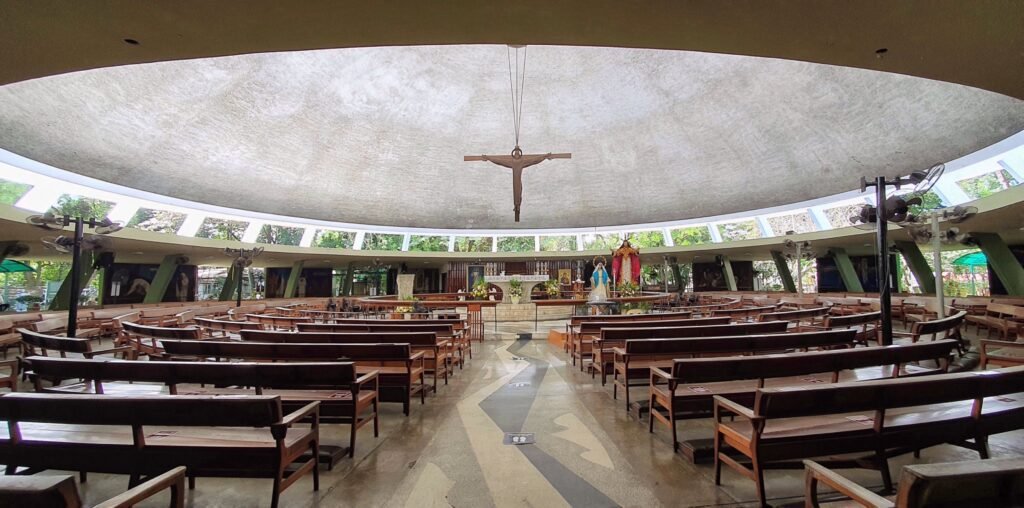

The Church of the Holy Sacrifice is Locsin’s first major architectural commission and is known to be the first circular chapel in the country to have an altar in the center. “It is to be noted that although the formal symbology was much appreciated by the parish, the central altar and the equal length of the aisles resulted in shortened linear processions,” Santillan explains. “Likewise, having the altar in the middle created the problem of where the Tabernacle would be situated. The priest had to turn to address the people seated behind him.”
Santillan uses this example to underline the importance of planning a church in accordance with the rites of worship. This mechanism “necessitates people to focus on the rites of Holy Mass,” which also addresses Modernism’s principle of “form follows function.” Nevertheless, Santillan says that the Church of the Holy Sacrifice is “arguably still a good example of a modern church in the Philippines.” How its early construction in the 1950s brought the community together and paved the way for collaboration among National Artists can still be seen in the current structure’s openness and straightforward beauty.
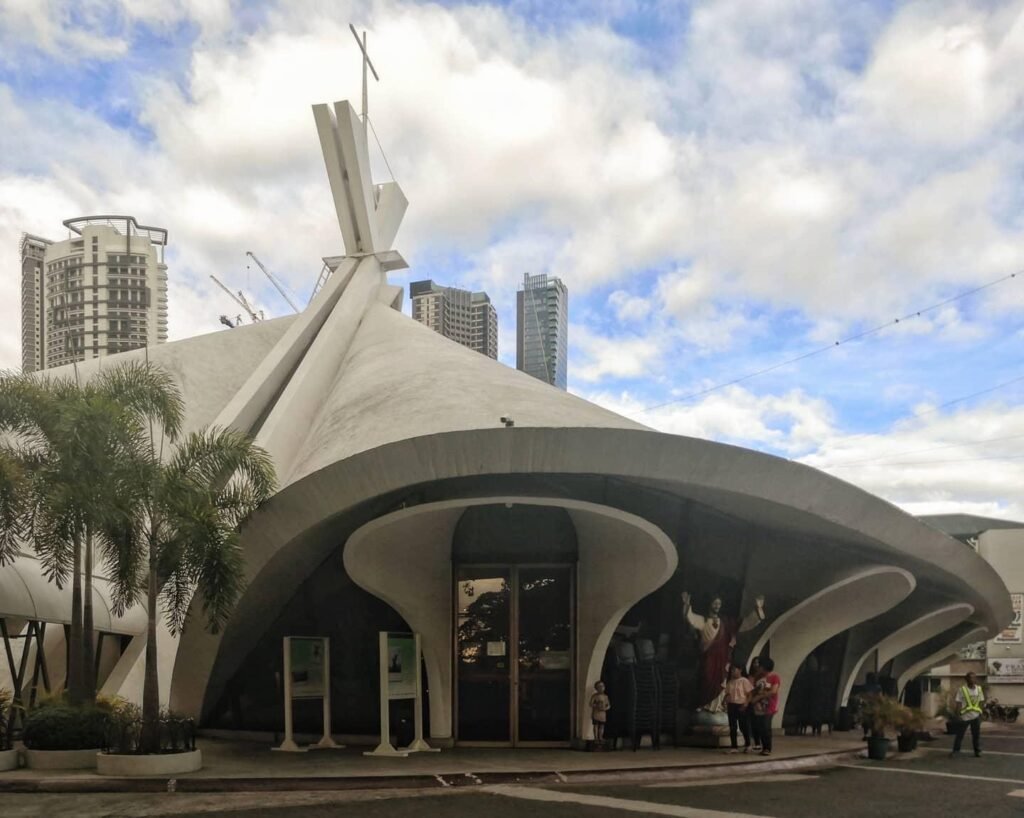

3) St. Andrew the Apostle Parish, Bel-Air II, Makati City
“Locsin later remedied his configuration in the Church of the Holy Sacrifice in St. Andrew the Apostle Parish in Makati,” says Santillan. The altar “was situated slightly off-center, which later elongated the aisle for processionals, as well as provided enhanced focus during the Mass.”
This St. Andrew the Apostle Parish was built over a decade after the Church of the Holy Sacrifice, with it completed on November 30, 1968. Its butterfly-shaped floor plan alludes to the manner by which St. Andrew the Apostle was crucified on a saltire or X-shaped cross. A crucified statue of St. Andrew was also placed at the left of the altar.


Architects also emphasize the act of worship and veneration through elements such as light. Santillan shares that the interiors of most older churches are darker “due to the lack of modern-day electricity when they were built. Thus, architects utilized sensitively-placed fenestrations to provide the contrast of light in the altar vs the darkness of the nave.” For St. Andrew the Apostle Parish, a massive circular chandelier hangs from the center to illuminate the interiors. This also acts as a halo to the crucified image of Jesus Christ in the middle, reminiscent of how early church architecture makes use of symbolisms.
St. Andrew the Apostle Parish remains in use up to this day. The parish is dedicated to its namesake, the patron saint of its very own Bel-Air Village and the entire Metro Manila.


4) National Shrine of Our Lady of the Miraculous Medal, Sucat, Muntinlupa City
Another circular structure by another National Artist for Architecture, the National Shrine of Our Lady of the Miraculous Medal by José Maria Zaragoza is a fitting example of maximizing height as an element in church architecture. This shrine is known for its dome that swirls into a 100-foot concrete tower.
Santillan shares that one way of looking at height in church architecture is that “the added elevation visually brings people higher, ergo, bridging the distance and bringing people closer to God.” The National Shrine of Our Lady of the Miraculous Medal even has a 70-foot steel cross standing on top of its concrete tower, allowing it to look very close to the skies.


Inside, the shrine’s ceiling follows the swirling pattern of the dome’s exterior. Pews are placed in lines facing an elevated altar, with the image of the Blessed Virgin Mary at the center. Zaragoza was said to be a Marian devotee and a master of ecclesiastical architecture, making this shrine one of his most notable works.
The Congregation of the Mission said that “as of 2017, the Our Lady of the Miraculous Medal National Shrine/Parish encompasses an area of 2.65 square kilometers and its current population is approximately 50,000 people.” The structure consistently plays host to the celebration of the feast day of the Miraculous Medal every November 27 and 28.


5) St. Alphonsus Mary de Liguori Parish Church, Magallanes Village, Makati City
Also known as Magallanes Church, the St. Alphonsus Mary de Liguori Parish Church was also designed by Leandro Locsin. This 800-square-meter parish was built in 1968, with a perfect square plan that measures 28 meters on each side. It initially had a flat roof, with a low ceiling height and dark lighting allowing the space to appear intimate.
When the original structure was destroyed by fire in 2004, only 28 buttresses survived. The parish then decided to save these and employ the help of Dominic Galicia Architects, whose goal was to have “a sustainable building that by its architecture minimizes its waste of materials and dependence on fossil fuels.” This was achieved by placing rows of clear glass that allow the natural light in and reusing the existing structure “as the springboard for soaring roofs.” The 28 buttresses were also originally hollow, so Dominic Galicia Architects filled them with concrete “to fulfill a new structural purpose of providing lateral support to the new composite columns that carry the roof vaults.” The new structure also increased seating from 300 to 900 through the incorporation of a mezzanine.
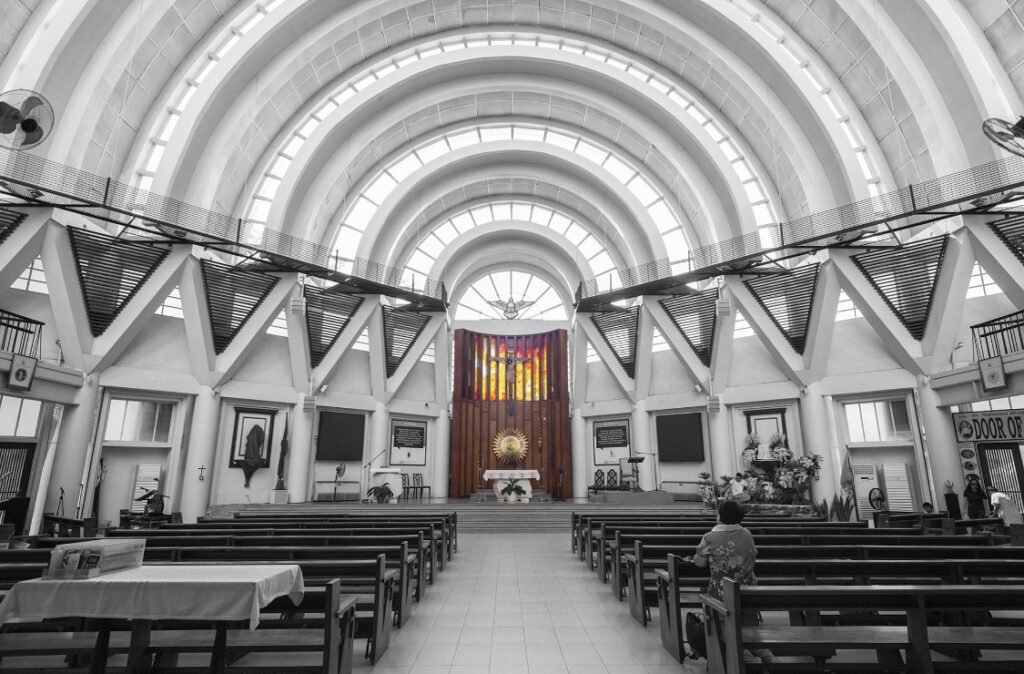

Magallanes Church is a reminder of how architecture is meant to represent meaning. While the original structure may have not survived and depicted suffering and even death, in the words of Dominic Galicia Architects, “the soaring new space speaks of paradise, grace, and resurrection.”
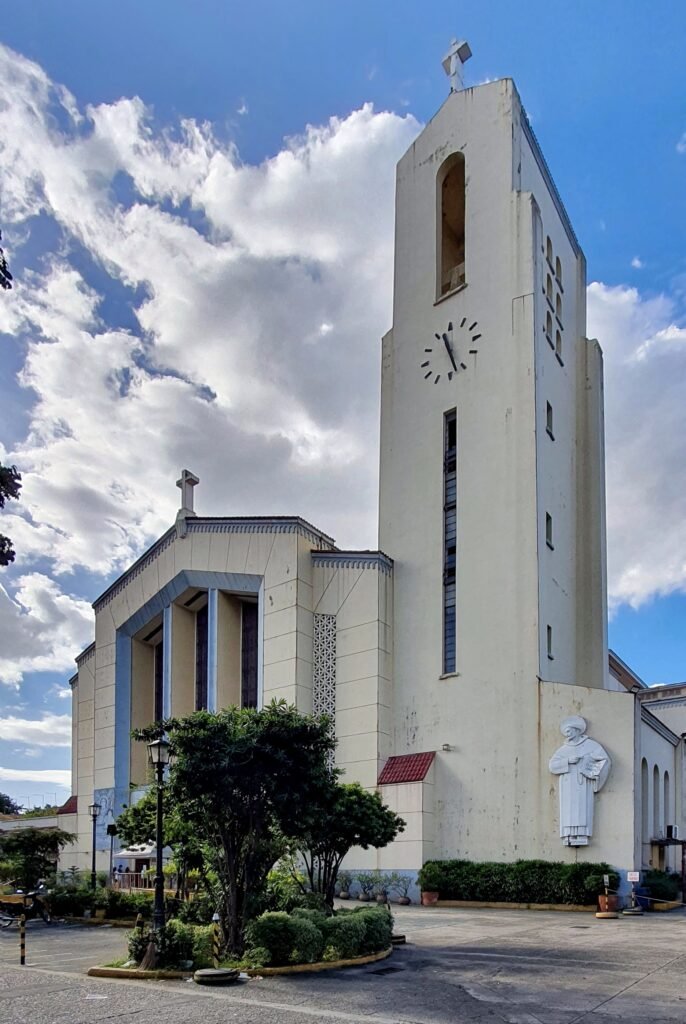

6) Santo Domingo Church, Quezon Avenue, Quezon City
The Santo Domingo Church is the largest church in Metro Manila and is one of the biggest churches in Asia. This 1954 church is known as the headquarters of the Dominican Order of the Philippines or Dominicans, who commissioned José Maria Zaragoza while he was still an architecture student at the University of Santo Tomas.
Following an Art Deco with Spanish Modern design, the church’s façade is identified by its receding planes. This structure exemplifies the concept of iconography in church architecture, with the giant bas-relief of Santo Domingo by Italian sculptor Francesco Monti seen upfront.
As the church is formally known as the National Shrine of Our Lady of the Most Holy Rosary, its colorful glass windows also depict the original 15 Mysteries of the Holy Rosary. Santo Domingo Church also houses the image of Our Lady of the Rosary, La Naval de Manila, the oldest Philippine-made ivory Marian icon in the country.
Every second Sunday of October, the Dominican Community, including students and staff from the University of Santo Tomas, Colegio de San Juan de Letran, and Assumption College, celebrate the feast day of La Naval de Manila through a procession that starts and ends at the Santo Domingo Church.
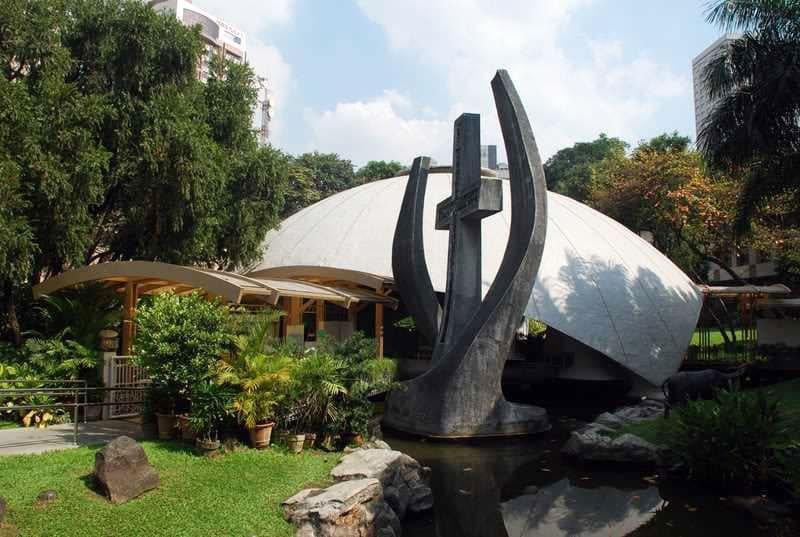

7) Greenbelt Chapel, Ayala Center, Makati City
With a dome-like structure that appears to be made of thin-shell concrete, the Greenbelt Chapel or Sto. Nino de Paz is often believed to be designed by Leandro Locsin. This belief holds no truth, as the chapel was a joint effort by architects Enrique Dizon, Topy Vasquez, and William Fernandez. The dome is steel-framed, clad with staggered thick marine plywood, waterproofing, and paint.
The story of the Greenbelt Chapel, based on the personal accounts of Vasquez, all started when husband and wife Nordy and Fanny Diploma decided to dedicate a temporary chapel to give thanks for Fanny’s recovery from cancer. The Diplomas owned one of the largest plywood manufacturing companies at the time. They then called their architect, Dizon, who then employed the help of Vasquez. Dizon rendered the circular pattern of the building while Fernandez designed the structure. Completed in 1983 and still standing up to this day, it can be said that “Fanny’s temporary chapel has outlived her.”
A cross inlaid with glass by contemporary Filipino glass sculptor Ramon Orlina that stands on water welcomes patrons. Inside, the layout follows semi-circular seating, with the altar situated on a higher level by means of steps. Santillan shares that this aspect is “partly to enhance visual connection with the people listening to the sermon. In a way, this may be likened to how a theater utilizes a stage so that the actors could be seen clearly.”
With glass sides that provide a view of lush greenery and skyscrapers, the Greenbelt Chapel has undoubtedly become a sanctuary in the heart of a busy city. It is also among the most visited spaces during the Christmas season’s celebrations of carols and Simbang Gabi.


The significance of preserving these structures, according to Santillan, is that church architecture reflects the changes in the ways people celebrate faith. “The forms, spaces, and ornaments in churches are tangible evidence of the development of religion in general…The reason why most architects aspire to design a church is that religious architecture allows designers to express themselves using more symbolic and experimental forms,” she says. “Perhaps one lesson that could be learned from all this is that we should not forget that architecture has meaning. All the forms, spaces, and ornamentations in a church are there for a specific reason and purpose. Architects should continue to seek to convey meaning in their forms and spaces regardless of function.” •
Caryn Paredes-Santillan is an architect and academic. She earned her Doctor of Engineering in Architectural Theory and Design from the University of Tokyo in 2007 and was a Post-Doctoral Researcher at the same institution until 2009. She was the Project Manager for the Delimitation of Core and Buffer Zones for the Baroque Churches of the Philippines and for Selected National Cultural Treasures under the National Commission for Culture and the Arts (NCCA) in 2011-2014. She was involved in several Conservation Management Plans (CMP), including Intramuros, San Sebastian Basilica, the Intendencia, and the Manila Central Post Office Building. She is currently Coordinator of the History, Theory, and Heritage Conservation Cluster of the UST College of Architecture and was Project Coordinator for the mASEANa International Student Workshop in 2021.
Gabrielle de la Cruz started writing about architecture and design in 2019. She previously wrote for BluPrint magazine and was trained under the leadership of then editor-in-chief Judith Torres and previous creative director Patrick Kasingsing. Read more of her work here and follow her on Instagram @gabbie.delacruz.


One Response